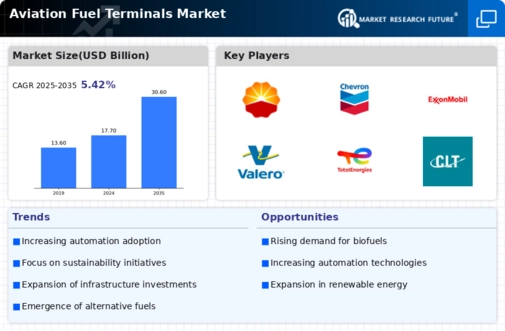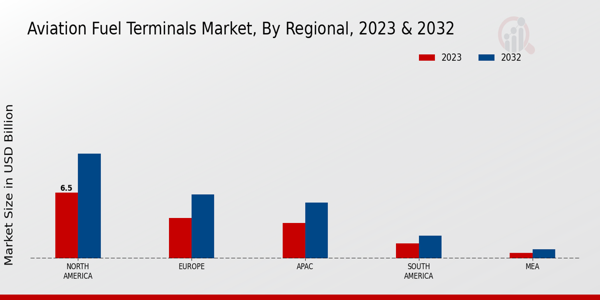Market Growth Projections
The Global Aviation Fuel Terminals Market Industry is poised for substantial growth, with projections indicating a market size of 17.7 USD Billion in 2024 and an anticipated increase to 30.6 USD Billion by 2035. This growth trajectory suggests a robust compound annual growth rate (CAGR) of 5.08% from 2025 to 2035. Such figures underscore the increasing importance of aviation fuel terminals in supporting the global aviation sector. As air travel continues to expand, the demand for efficient and reliable fuel supply systems will likely drive further investments in terminal infrastructure and technology.
Increasing Air Traffic Demand
The Global Aviation Fuel Terminals Market Industry is experiencing a surge in demand driven by the increasing air traffic globally. As more passengers and cargo are transported via air, the need for efficient fuel supply chains becomes paramount. In 2024, the market is projected to reach 17.7 USD Billion, reflecting the industry's response to this growing demand. Airports and airlines are investing in infrastructure to enhance fuel storage and distribution capabilities, ensuring that they can meet the needs of a burgeoning aviation sector. This trend is expected to continue, with the market anticipated to grow significantly in the coming years.
Expansion of Airport Infrastructure
The expansion of airport infrastructure is a critical driver for the Global Aviation Fuel Terminals Market Industry. As airports undergo modernization and expansion to accommodate growing passenger and cargo traffic, the demand for aviation fuel terminals increases correspondingly. New terminals are being constructed with advanced fuel storage and distribution systems to ensure that they can support the anticipated growth in air travel. This expansion is projected to contribute significantly to the market's growth, with an expected CAGR of 5.08% from 2025 to 2035, reflecting the ongoing investment in airport facilities and the associated fuel supply chain.
Strategic Partnerships and Collaborations
Strategic partnerships and collaborations are emerging as a key driver in the Global Aviation Fuel Terminals Market Industry. Fuel suppliers, airlines, and airport authorities are increasingly working together to streamline operations and enhance fuel supply chains. These collaborations often lead to shared investments in infrastructure and technology, which can significantly reduce costs and improve service delivery. By pooling resources and expertise, stakeholders can better respond to market demands and regulatory challenges. This trend is likely to bolster the market's growth, as collective efforts can lead to more resilient and efficient fuel terminal operations.
Technological Advancements in Fuel Management
Technological innovations are reshaping the Global Aviation Fuel Terminals Market Industry, enhancing efficiency and safety in fuel management. Advanced monitoring systems and automation technologies are being integrated into fuel terminals, allowing for real-time data analysis and improved operational efficiency. These advancements not only reduce the risk of fuel contamination but also optimize inventory management, leading to cost savings. As the industry adapts to these technologies, terminals are likely to see increased throughput and reduced operational costs, contributing to the overall growth of the market, which is projected to reach 30.6 USD Billion by 2035.
Regulatory Compliance and Environmental Standards
The Global Aviation Fuel Terminals Market Industry is significantly influenced by stringent regulatory compliance and environmental standards. Governments worldwide are implementing regulations aimed at reducing carbon emissions and promoting sustainable aviation fuels. This regulatory landscape compels fuel terminals to adopt cleaner technologies and practices, which may initially require substantial investment but ultimately leads to long-term operational efficiencies. Compliance with these regulations not only enhances the reputation of fuel suppliers but also aligns with the global shift towards sustainability, thereby driving growth in the market as stakeholders increasingly prioritize eco-friendly practices.













